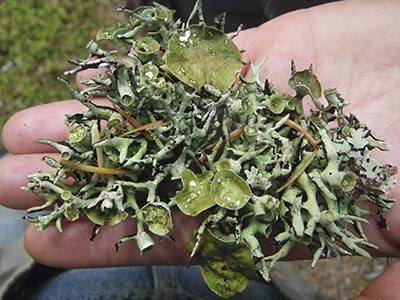by Russel Barsh and Madrona Murphy
Lichens are most conspicuous in winter when vascular plants turn brown or lose their leaves: crinkly green rosettes on rocks and tree trucks, stringy greenish hair draped over branches, balls of pale “reindeer moss” resting on darker green carpets of moss. The lichens of the San Juan Islands are exceptionally diverse and ecologically significant. But what, exactly, is a lichen?
Lichens are multi-species communities that can reproduce themselves. A lichen is composed of members of not one but three Kingdoms: the Fungi, Protists (Algae), and Bacteria (Cyanobacteria), living symbiotically. The fungal partner (or mycobiont) builds the physical structure that safely encloses, and controls the reproduction of the algal and bacterial partners (the photobionts), which use solar energy to manufacture carbohydrates to share with the fungus.
If the lichen includes a cyanobacterium, it can also harvest nitrogen directly from air instead of recycling nitrates from decaying organic matter (like plants), or consuming and recycling the protein in organisms (like animals).
Fungi were one of the first life forms on earth, appearing over a billion years ago, and like animals, fungi feed on other organisms. Most of the fungi parasitize living plants or animals, or obtain energy and nutrients by decomposing ones. But lichenized fungi are farmers: they build tiny gardens of carefully selected algae and bacteria to produce food. Indeed, lichenologists refer to the “domestication” of algae by fungi.
We maintain our best potato and apple varieties by propagating them vegetatively (asexually) rather than letting them go to seed. Similarly, the photobionts in lichens may be restricted to reproducing clonally by cell division, which preserves particular algal or cyanobacterial variety. The fungal partner continues to reproduce sexually, however.
Lichen reproduction is complex and puzzling. Sometimes, the lichen grows brittle stalks (isidia) that contain both fungal and bacterial cells. Isidia simply break off and roll, blow or wash away to grow into new lichens: asexual or vegetative propagation. At other times, lichens produce fibrous balls (soredia) that contain fungal spores and a tiny starter set of photobionts: a spaceship with a seed packet. Soredia can survive longer trips than isidia, whether borne by wind or rain, on animals’ fur, or inside animals’ stomachs.
As some lichens grow larger, they switch from making isidia to making soredia. Other lichens grow isidia if they are growing close to the ground, and soredia if they are growing high up on a tree truck or boulder, exposed more to the wind. This may help disperse soredia farther than isidia.
There are even reports of lichens simply dispersing fungal spores without a supply of photobionts. Fungal spores can only become new lichens if they happen to encounter appropriate algal or cyanobacterial cells in the environment and capture them. Is this a way of creating new kinds of lichen communities? We simply do not yet know how most kinds of lichens reproduce, or the frequency with which new combinations of mycobionts and photobionts may arise from generation to generation.
Slugs and snails are major consumers of lichens in the islands. Sporedia that pass through these animals’ digestive tracts unharmed are “planted” in slime trails. But some lichenizing fungi produce powerful molluscicidal compounds. If they poison slugs, does this favor dispersal by birds or small mammals that sometimes eat lichens or collect them for nesting material?
Lichens grow anywhere there is light, even in deserts, on icy mountain peaks, in the far North and Antarctica. Since lichens absorb water directly from air, they need no roots. Lichens need very little water to grow, and can remain viable for months or years with no water at all: crisply desiccated, but able to revive and resume photosynthesizing within minutes of being wetted. This capability suits lichens perfectly for environments where much of the year is dark, cold and dry.
The flip side of lichens’ extraordinary ability to survive in marginal habitats such as boulders and mountaintops is very slow growth, ordinarily barely one millimeter (one twenty-fifth of an inch) per year. Accordingly, lichens are mainly found in habitats such as bare rock, thin soils, roofs and walls where faster-growing mosses and vascular plants have difficulty gaining a roothold.
Lichens can play a crucial role in the colonization of geologically young habitats, such as freshly cooled lava, newly formed islands, or in our region, bedrock scraped bare by glacial ice. Over centuries, lichens form living mats on rocks and gravel that gradually contain thin reservoirs of nutrients and water, the beginning of moist soils in which seeds can sprout and grow.
Kwiaht researchers have been studying the impact of human activity on carpets of lichens and mosses in the San Juan Islands National Monument. To learn more about the biology and ecology of lichens, watch for their upcoming presentation at the Lopez Island Garden Club!



